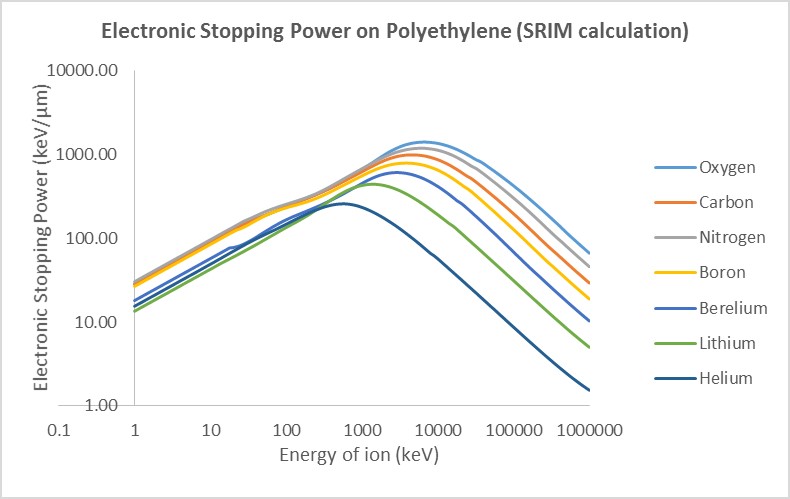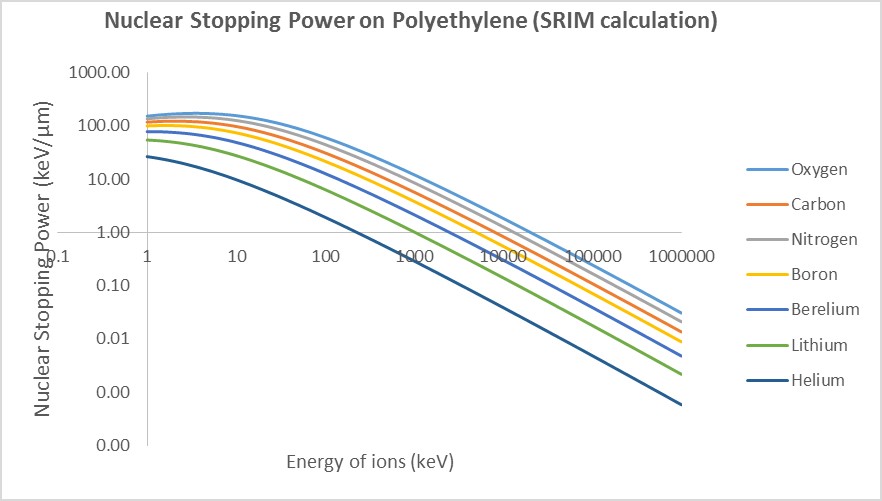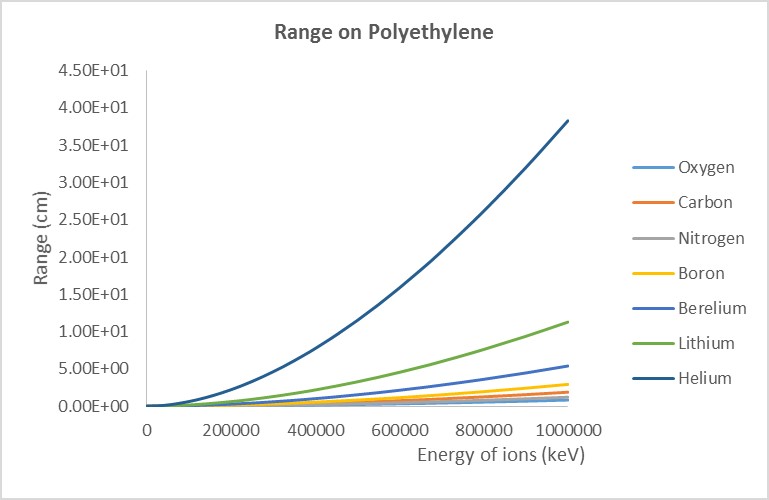Date: Wed, 19 Jul 2017 14:40:00 -0500
Dear all,
I did some correction on my input file as suggested by Andrea. I also
compiled ldpmqmd and ldpm3qmd scripts and I didn’t notice any difference.
Here is my question.
I have a beam of 1 GeV protons and my target is pure Polyethylene. The SRIM
calculation shows that the electronic (or total) stopping power for 1GeV
proton in Polyethylene is 0.22 keV/micron and the range is about 331 cm. I
get an exact same result from FLUKA simulation too. I mean, the LET
spectrum calculated at different depths within Polyethylene due to 1GeV
proton beam shows a single peak at 0.22 keV/micron such that the height of
the peak decreases as we go deeper in Polyethylene. Using a separate
calculation and scoring the dose with USRBIN for the same setup gives me
the range to be about 331 cm.
My question is if the proton interacts with the target atoms (Carbon and
Oxygen in my case), I expect the fragments of these atoms with Z < 6 or Z
<8. The energy transferred to each fragment is definitely less than 1 GeV.
So using SRIM, I calculated the stopping power (electronic and nuclear) for
all the ions from Helium to Oxygen and for energies from 1 keV to 1GeV,
please see the attached diagrams. And I also have a plot of the range on
Polyethylene of these ions for the same energies. It’s clear that if the
target fragments exist, they don’t go very far but I guess they transfer
some energy into the medium. This should result in some peaks (in addition
to the one at 0.22 keV/micron due to primary protons) in the LET spectra
calculated at various depths. But I don’t get such result. Am I still
missing something in my input file?
Here is what I did. Based on the range of 1GeV proton on Polyethylene, I
extended the size of Polyethylene to about 343 cm. I am calculating LET
spectra on water (detectors, 0.06 cm thick slabs of water) placed at every
10 gm/cm^2 of Polyethylene. I am using PHYSICS: IONSPLIting, EVAPORATion,
COALESCE, and TRANSPORT: IONTRANS (Full transport). Please take a look at
my input files. One input file has smaller geometry and other has
everything same except Polyethylene extends to larger depth.
By the way, when I activate TRANSPORT card, my PHYSICS (EVAPORAT) card
options automatically change into “ignore”.
Thank you in advance.
Kindly,
Rajesh Panthi
On Sat, Jul 8, 2017 at 11:30 AM, Andrea Fontana <andrea.fontana_at_pv.infn.it>
wrote:
> Hi Rajesh,
> did you build the FLUKA executable with the DPMJETt and RQMD libraries?
> This is the recommended way to account for A-A interactions above 125 MeV/n
> (see the ldpmqmd script in $FLUPRO/flutil).
>
> Looking at your input files, I also recommend that you enable COALESCENCE
> in the PHYSICS card to properly model nuclear fragmentation.
>
> Hope this helps,
> Andrea
>
>
> Il 07/07/2017 18:12, Panthi, Rajesh ha scritto:
>
>> Hi FLUKA experts,
>>
>> I am using USRYIELD to score LET spectra at various depths within
>> polyethylene due to a beam of (i) heavy ions, for example, 150 MeV/n Fe,
>> and (ii) 1 GeV protons. It appears to me that only the LET spectra due to
>> the beam fragmentation are scored. I mean, in the case of Iron beam, only
>> the LET spectra corresponding to fragmentation of Iron ions are scored.
>> If I use a proton beam, I expect the interaction between the proton and
>> carbon nuclei (in the case of polyethylene as a target material) thereby
>> producing atoms/ions with Z<6. Although such fragmentations have very short
>> range, they do transfer energy to the medium locally (local energy
>> transfer). Based on the result I get with the proton beam, I don't see any
>> such LET spectra. Can we not score it or I am doing something wrong here?
>> Please take a look at my input file and give me some suggestion.
>>
>> Kindly,
>>
>> Rajesh Panthi
>>
>>
> --
> ========================================================================
> Dr. Andrea Fontana tel: +39 0382 987991
> Istituto Nazionale fax: +39 0382 423241
> di Fisica Nucleare
> Sezione di Pavia e-mail: andrea.fontana_at_pv.infn.it
> Via Bassi 6 web : www.pv.infn.it/~fontana
> 27100 PAVIA, Italy
> ========================================================================
>
>
__________________________________________________________________________
You can manage unsubscription from this mailing list at https://www.fluka.org/fluka.php?id=acc_info

(image/jpeg attachment: Electronic_Stopping_Power__SRIM_.jpg)

(image/jpeg attachment: Nuclear_Stopping_Power__SRIM_.jpg)

(image/jpeg attachment: Range_on_Polyethylene_SRIM.jpg)
- application/octet-stream attachment: proton1GeVPE10cm.inp
- application/octet-stream attachment: protonPE.inp